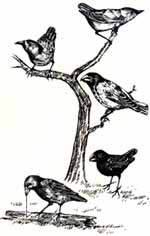 | 

Does "The Beak of the Finch" Prove Darwin Was Right?
Supplemental Reading | |
John D. Morris, Ph.D.
Back To Genesis
No. 72b, May 1989
|  | 
As the naturalist on the H.M.S. Beagle, Charles Darwin made numerous valuableobservations of as yet undiscovered plants and animals. Along the way, theH.M.S. Beagle anchored for an extended stay in the Galapagos Islands, 600 miles offthe western coast of South America. While the crew mapped these ruggedvolcanic islands, Darwin studied the unique animals living there, especiallythe numerous varieties of finches, today classed as fourteen differentspecies. Numerous features suggested to Darwin that these birds were relatedto each other and related to similar birds in South America. Yet they showedsignificant differences between them, including some features not found inSouth America. Of particular interest were the beaks. Some were small,others parrot-like. Some were curved, one had a boring beak.
 | | Some creationists of Darwin's day held to the absolute immutability ofspecies, that God had created each species for each specific ecologicalhabitat, and no significant changes had ever occurred or could ever occur.But, to Darwin, these animals appeared to be related and now showed muchvariety. They further appeared to have migrated from South America andacquired other traits after arrival. He could not reconcile the evidencewith this particular creationist teaching. Thus his concept of evolution bynatural selection began to take form. But today's creationists, and even some in Darwin's day, freely allow forlimited change within created kinds, or basic categories. It is within thecreationist model to propose that the present varieties of finch descendedfrom one or more ancestral categories of finch and that migration of animalsinto new areas can and does happen. Creationists agree fully with Darwinover the finches. But they disagree with the wholly unsupported evolutionaryspeculation that finches evolved from fish and ultimately from single-celledorganisms. Rather, the evidence better fits the idea that each basiccategory of animal was created as that category. Changes are limited by thegenetic information present at the start.
 |  | | What, then, are we to make of the recent newspaper articles worldwideproclaiming that a new study of finches and their beaks have shown "Darwinwas Right"? A team of Princeton scientists have won a prestigious award for20 years of study of the finch's beaks on one tiny island in the Galapagoschain, home of only a few finch species, and a best-selling novel entitled,The Beak of the Finches, tells their story and explains their findings. Justwhat was found? The two scholars, Drs. Peter and Rosemary Grant observed how, under droughtconditions, birds with larger beaks were better adapted than others, thustheir percentage increased. But this trend reversed when the cyclicalconditions reversed. Furthermore, in times of drought, the normally separatespecies were observed to cross-breed. They are related after all. Darwin wasright! But is this really evolution? Even after the changes there is still the samearray of beak sizes and shapes. This is variation and adaptation, notevolution. Actually, de-evolution has occurred; the observation is that there arelarger groupings of species into what may be more reminiscent of theoriginally created kind. Creation agrees with Darwin's observations and withthe newer observations, but evolution doesn't, even though the Grantsinterpret this as rapid evolution. Wonderful study, great data, wronginterpretation. |
"Vital Articles on Science/Creation"
May 1989
Copyright © 1989 All Rights Reserved |
 |

